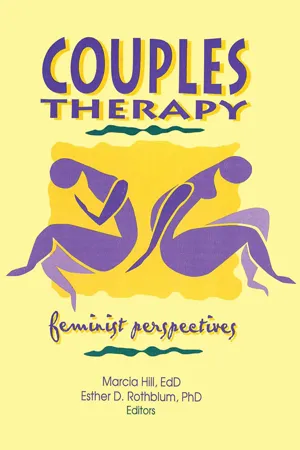Cultural Considerations in Therapy
Cultural considerations in therapy involve recognizing and respecting the influence of a client's cultural background on their beliefs, values, and behaviors. It requires therapists to adapt their approach to be culturally sensitive and to understand how cultural factors may impact the therapeutic process. This includes acknowledging and addressing potential cultural biases and stereotypes that may affect the therapeutic relationship.
7 Key excerpts on "Cultural Considerations in Therapy"
- eBook - ePub
Couples Therapy
Feminist Perspectives
- Esther D Rothblum, Marcia Hill(Authors)
- 2014(Publication Date)
- Routledge(Publisher)
...Cultural Considerations in Couples Therapy Pamela A. Hays SUMMARY. This paper offers a framework for considering cultural influences in couples therapy. Emphasis is placed on the therapist’s responsibility to engage in an ongoing self-assessment of personal biases, areas of inexperience, and privilege. With a focus on couples of ethnic minority cultures, suggestions are offered for establishing rapport, understanding values, and appreciating strengths. [Article copies available for a fee from The Haworth Document Delivery Service: 1-800-342-9678. E-mail address: [email protected]] While family systems and feminist therapies have raised awareness of the need to consider an individual’s social context, both of these fields have until recently paid little attention to the contexts of people of color (Brown, 1994; Brown & Root, 1990; McGoldrick, Pearce, & Giordano, 1982). The purpose of this paper is to encourage therapists to consider cultural influences in their work with diverse couples. A framework is described for considering cultural (including gender-related) influences on both clients and therapists. The importance of personal work aimed at challenging one’s own biases is discussed. And with a focus on couples of ethnic minority cultures, suggestions are offered for establishing rapport, understanding values, and appreciating strengths. BECOMING MORE CULTURALLY RESPONSIVE In recognition of the needs of minority cultures and groups traditionally excluded from psychological research and practice, the American Psychological Association (1993) recently published the “Guidelines for Providers of Psychological Services to Ethnic, Linguistic, and Culturally Diverse Populations.” The American Counseling Association’s Division of Multicultural Counseling and Development has published a similar set of “Multicultural Counseling Competencies and Standards” for counselors (Sue, Arrendondo, & McDavis, 1992)...
- eBook - ePub
Foundations of Counseling and Psychotherapy
Evidence-Based Practices for a Diverse Society
- David Sue, Diane M. Sue(Authors)
- 2012(Publication Date)
- Wiley(Publisher)
...In other situations, differences might be quite important to the client or to the therapist. In the multicultural counseling field, attention is often given to “client differences.” However, as emphasized throughout our book, it is equally important to consider therapist background characteristics and reactions. In Chapter 4, we discussed the importance of therapists knowing themselves, their values, their reactions, and their prejudices. As we examine the important topic of diversity considerations in counseling, we hope you will take the time to reflect on these topics as they pertain to you individually. If you think of your classmates or colleagues in the fields of counseling, psychology or social work, you will get a feel for the diversity in backgrounds, values, and beliefs of those in the mental health profession. When individual therapist characteristics are combined with client differences, the potential diversity is immense. Because there is no multicultural therapy, we have decided to use this chapter to present practical issues faced by therapists when working with clients who differ from the therapist in terms of values, or social, cultural, or ethnic background. In the following sections, we will not attempt to provide how-to information, but instead will raise issues that might be important to consider when there are specific differences between therapist and client. We will also discuss issues involved in working with specific diverse populations and conclude with suggestions on how we can improve cultural competence through case presentation and supervision. We will begin by sharing some considerations regarding the perceived effectiveness of therapists regarding cross-racial dyads and the circumstances under which differences should be acknowledged. Acknowledging Differences: Respect and Understanding Are the Key Multicultural theory would seem to indicate that to be culturally competent, we need to show respect for clients’ ethnicity and background...
- William T. O'Donohue, Jane E. Fisher, William T. O'Donohue, Jane E. Fisher(Authors)
- 2009(Publication Date)
- Wiley(Publisher)
...Even when the cultural backgrounds of clients and therapists are similar, there is still a need to recognize and deal with cultural influences. Becoming a skilled therapist requires an appreciation for the influence of cultural factors on both the client and the therapist, this active appreciation of cultural influences ultimately resulting in culturally competent psychotherapy. Increasing knowledge about cultural influences; increasing self-awareness about cultural biases, assumptions, and beliefs; and open communication about sensitive issues related to culture result in a more positive psychotherapy experience. CBT represents an ideal treatment vehicle for the culturally responsive application of theoretically grounded and empirically supported change strategies to client problems. References American Medical Association Council on Science and Public Health. (2008). Optimizing care for gay men and lesbians. Retrieved July 9, 2008, from www.ama-assn.org/ama/pub. American Psychological Association. (1993). Guidelines for providers of psychological services to ethnic, linguistic, and culturally diverse populations. American Psychologist, 48, 45-48. American Psychological Association. (1997). Commission on ethnic minority recruitment, retention and training in psychology (CEMRATT). Washington DC: Author. American Psychological Association (2000). Guidelines for psychotherapy with lesbian, gay, and bisexual clients. American Psychologist, 55, 1440-1451. American Psychological Association (2003a). Guidelines and multicultural education, training, research, practice, and organizational change for psychologists. American Psychologist, 58, 377-402. American Psychological Association (2003b). Guidelines for psychological practice with older adults. Guidelines for psychological practice with older adults. Washington, DC: Author. Atkinson, D. R., Morten, G., & Sue, D. W. (1993). Counseling American minorities: A cross-cultural perspective. Dubuque, IA: William C...
- eBook - ePub
- Joseph L. Wetchler, Joseph L. Wetchler(Authors)
- 2011(Publication Date)
- Routledge(Publisher)
...The authors (Wylie & Perrett) suggest that therapists using particular therapeutic models with culturally different couples should question the assumptions and values upon which the models are based and not assume that all models can be appropriately adjusted to equally serve all clients across all cultures. The authors also suggest that seeking supervision and working with a co-therapist are effective methods that provide therapists with opportunities to question their assumptions, seek differing perspectives, and challenge their belief systems when confronted with differing cultural value systems. Professional guidelines of ethical conduct such as AAMFT’s code of ethics (2001) provide an institutional framework for therapists to engage in clinical practice that is ethical, appropriate, and demonstrates competence. However, beyond formal professional codes of ethics, couple therapists should consider their own cultural context, the cultural contexts of their clients, their own and their clients’ values and worldviews, and the importance of imbuing their practice with openness to and expression of a diversity of cultural perspectives and experiences. Impact of Culture in Couple Therapy Defining Culture The term “culture” encompasses a myriad of implicit and explicit variables including race, socioeconomic class, gender, and sexual orientation. In its broadest sense, culture is defined as a set of shared symbols, beliefs, and customs that shape individual and group behavior (Goodenough, 1999). Culture also provides us with a set of guidelines for speaking, doing, interpreting, and assessing actions and reactions in life (Dilworth-Anderson, Burton, & Klein, 2005). Broadly speaking, culture and cultural experiences provide definition to almost every aspect of our lives from our worldviews, values and beliefs to how we dress, speak, work, play, and engage with the world around us...
- eBook - ePub
Core Competencies in Cognitive-Behavioral Therapy
Becoming a Highly Effective and Competent Cognitive-Behavioral Therapist
- Cory F. Newman(Author)
- 2013(Publication Date)
- Routledge(Publisher)
...10 Practicing Cognitive-Behavioral Therapy with Cultural and Ethical Sensitivity “I am not Athenian or Greek but a citizen of the world.” Socrates The term “culture” refers to the unique behavior patterns, attitudes, values, worldviews, and lifestyle shared by a group of people that distinguish them from other groups (Tseng & Streltzer, 2004; Whaley & Davis, 2007). Clinicians are increasingly expected to be culturally sensitive and culturally competent. Cultural sensitivity involves the clinician’s “awareness of cultural variables in themselves and in their client that may affect the therapeutic relationship and treatment process” (Sperry, 2010, p. 198). Cultural competency involves the clinician’s ability to understand and be responsive to clients from the perspective of their particular subgroup, acknowledging the importance of cultural differences in assessing psychopathology and in designing appropriate interventions; being mindful and respectful of cultural strengths; and valuing the expansion of one’s knowledge base in order to maximize meeting the needs of clients from a variety of backgrounds (López, 1997; Sue, 1998). This chapter summarizes some of the ways in which competent CBT clinicians strive to make adaptations to improve their therapeutic relationship skills, case formulations, and interventions to be optimally effective with clients from diverse backgrounds...
- eBook - ePub
Cultural Humility in Art Therapy
Applications for Practice, Research, Social Justice, Self-Care, and Pedagogy
- Louvenia Jackson(Author)
- 2020(Publication Date)
- Jessica Kingsley Publishers(Publisher)
...Multicultural counseling should not be looked upon as an “extra skill” but an integrated component of all forms of therapy. Sadeghi, Fischer, and House (2003) add to this by stating: The textbook and research findings and psychological theories often contained culture-specific assumptions. Some of these assumptions include a universal definition of what constitutes “normal” behavior, individualism as preferable to collectivism, independence as more desirable than dependence, an emphasis on understanding linear thinking where each cause has an effect and each effect a cause, and the paradigm wherein counselors change an individual to fit the system rather than changing the system to the individual. (p.180) This describes a culturally humble counselor, one who understands that all individuals providers work with have cultural identities, lived experiences, and tacit knowledge that may or may not align with their own. This is the underlying concept of the cultural humility principles, that one must work to readdress the power imbalance in the patient–provider dynamic, in addition to developing mutually beneficial partnerships with communities on behalf of individuals and defined populations (Tervalon & Murray-Garcia, 1998). As culture assumptions are found in art therapy, Hocoy (2002) states that art therapy has also been derived from Western therapeutic traditions and it is important for the field to acknowledge that in order to make progressions in cross-culturalism. He also states that art therapists can do a few things to maximize the likelihood of the ethical and effective treatment of individuals from a non-Euro-American culture, such as engaging in rigorous and honest self-examination as to their cultural competency, continual professional development in multicultural competency through readings, workshops, and consulting with members of the community in which the therapist is working (Hocoy, 2002)...
- eBook - ePub
- Windy Dryden, Andrew Reeves(Authors)
- 2013(Publication Date)
- SAGE Publications Ltd(Publisher)
...What we generally mean by ‘psychological therapy’ is an essentially talking-and-listening form of help that does not primarily utilise medical or physical means. While this could broadly include any spiritual or philosophical concepts and techniques (these are, after all, not medical or physical), it tends not to. Since psychology is promoted as a scientific discipline, clinical psychology, and latterly counselling psychology, have been advanced as applied scientific professions, in turn suggesting a superiority over earlier religious and philosophical traditions of helping people with their problems in living. 3 CURRENT SOCIOCULTURAL CONTEXTS OF THERAPY IN BRITAIN Cushman’s (1995) seminal text on the historical development of psychotherapy within the American context remains highly instructive but no directly comparable British text exists. Cushman’s analysis problematises the rise of the peculiarly Western sense of self and Rose’s (1989) analysis of British trends in the rise of psychology and its influences on our sense of a private self has some resonances (see also Wright (2011) for an Australian-based but widely applicable view). Significantly, in spite of a decades-long tradition of couple counselling and group therapy, individual therapy remains by far the preferred choice. We were told by the authors of one piece of (market) research (BACP/FF, 2004) that 21 per cent of the British population had had some form of counselling or psychotherapy and that up to 82 per cent of people would willingly have therapy if they thought they needed it. Previous estimates of the numbers experiencing therapy had been around 5 per cent at most and there may be reasons to doubt a figure as high as 21 per cent. Nevertheless, since the struggling 1970s, when counsellors and psychotherapists encountered a great deal of public and media resistance, acceptance has continued to grow...






